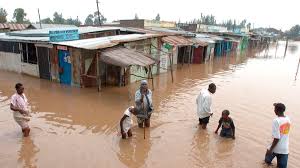Nairobi, Kenya – The serene landscapes of Kenya have reworked into scenes of devastation because the nation grapples with extreme flooding, inflicting widespread destruction and displacement. Recent heavy rains have unleashed chaos throughout a number of components of the nation, marking a grim interval of loss and upheaval.
Local media retailers report that the catastrophic climate occasions in latest days have claimed the lives of 11 people, with the variety of displaced individuals hovering above two thousand. The floods have obliterated houses, farmlands, and infrastructure, leaving many in dire want of help and shelter.
Willis Omulo, a resident of Homa Bay within the nation’s west, paints a bleak image of the scenario. “We have people who have been internally displaced, who don’t have a place to call home, no roof over their heads, their farmlands have been submerged,” Omulo says. The floods haven’t solely wreaked havoc on human settlements however have additionally intensified human-wildlife conflicts. “Here we are talking about hippos that are marauding within the community, scavenging for pasture because their grazing lands have been submerged. This is really a threat to the community and [is] causing a lot of insecurity,” he provides, highlighting an typically ignored consequence of such pure disasters.
Kenya’s meteorological division had issued warnings of very excessive rainfall, urging the populace to brace for floods. Despite these advisories, the size and ferocity of the floods took many without warning. In Kirinyaga county, as an example, floodwaters swept away group roads, paralyzing transport providers and reducing off communities.
A harrowing incident on Tuesday underscored the perilous nature of the scenario when 51 passengers had been rescued after their bus was swept away by floodwaters on a bridge in northern Kenya. Such incidents underscore the instant risks posed by the flooding, however in addition they level to the longer-term implications for the nation’s infrastructure and catastrophe preparedness mechanisms.
The Bigger Picture
The floods in Kenya function a stark reminder of the broader implications of local weather change. Increasingly erratic climate patterns, characterised by extended droughts interspersed with intense durations of rainfall, have gotten extra widespread in components of Africa, together with Kenya. These occasions not solely threaten lives but in addition livelihoods, notably in agricultural communities depending on predictable climate cycles.
This catastrophe requires a twofold response. Firstly, there may be a right away want for humanitarian help to assist these affected by the floods. This consists of offering shelter, meals, clear water, and medical providers to the displaced populations and investing in infrastructure restore and reconstruction.
Secondly, and maybe extra crucially, this incident highlights the pressing want for complete catastrophe preparedness and local weather adaptation methods. This includes not solely enhancing early warning methods and evacuation plans but in addition investing in sustainable growth practices that cut back vulnerability to excessive climate occasions.
The devastating floods in Kenya are a wake-up name to the pressing challenges posed by local weather change. As the nation begins the arduous technique of restoration and rebuilding, it’s crucial that these classes not go unheeded. A concerted effort from the federal government, worldwide group, and civil society is crucial to not solely tackle the instant disaster but in addition to put the groundwork for a extra resilient and sustainable future.
https://www.africanexponent.com/devastating-floods-in-kenya-a-wake-up-call-to-climate-action/


